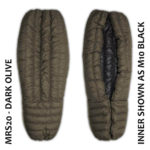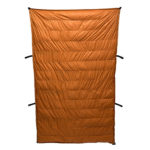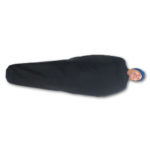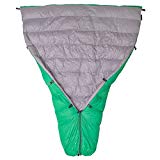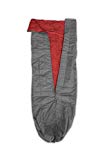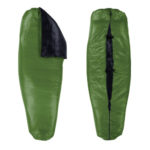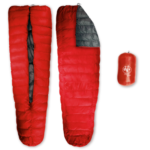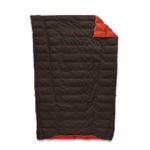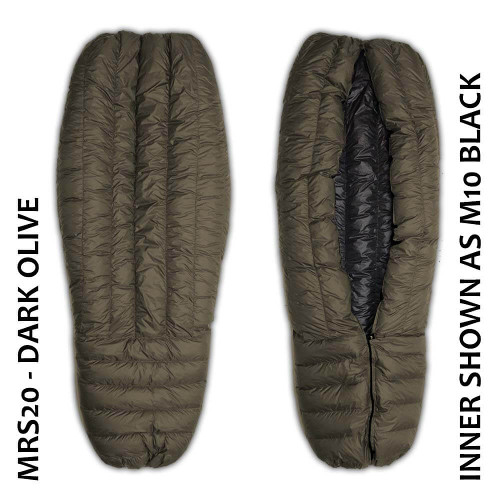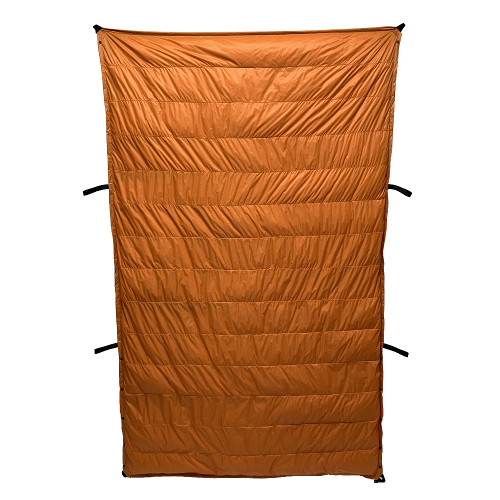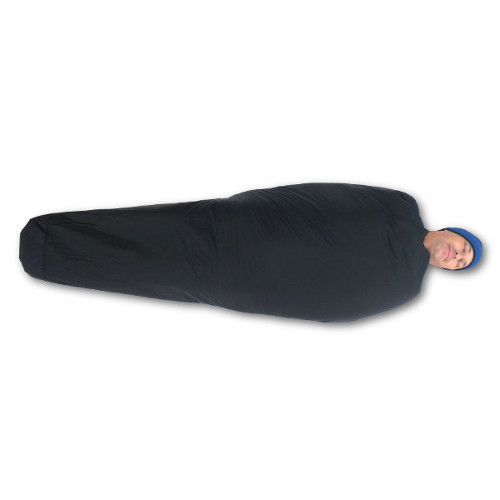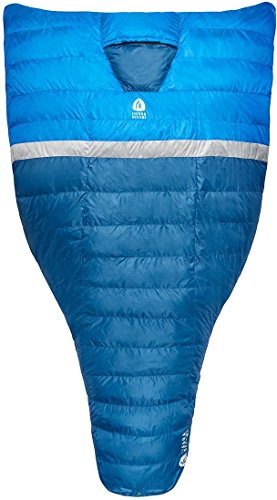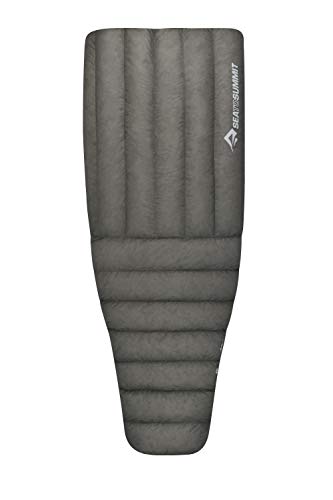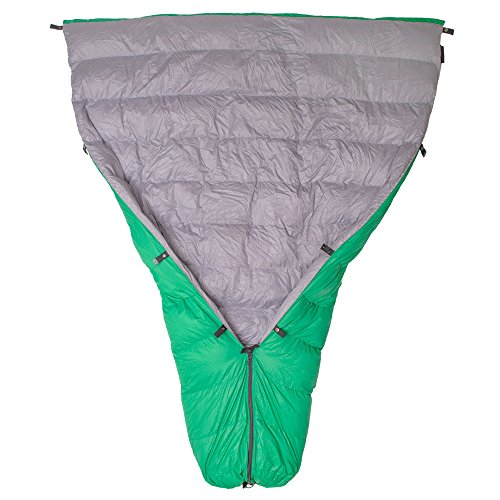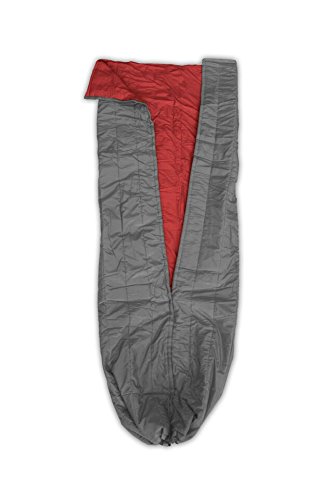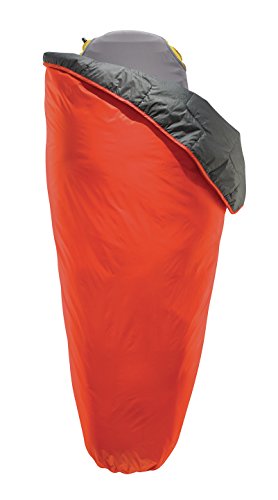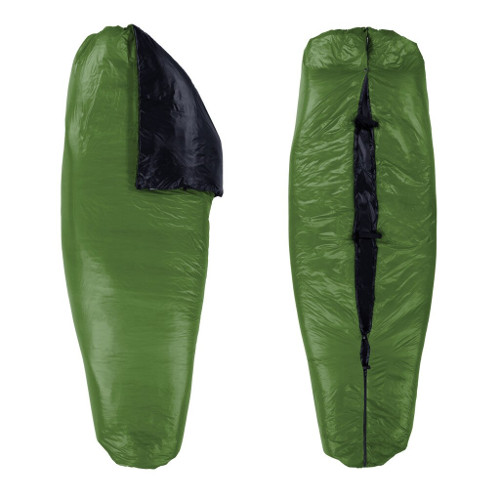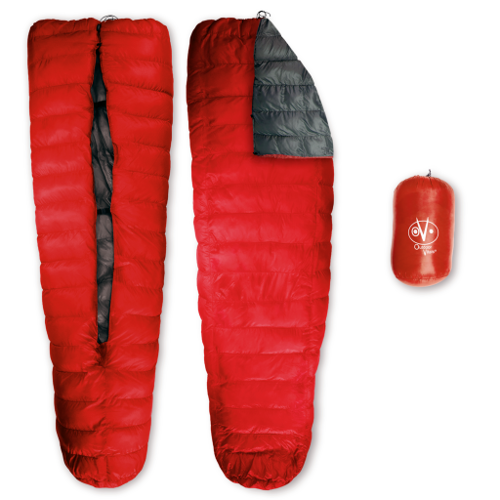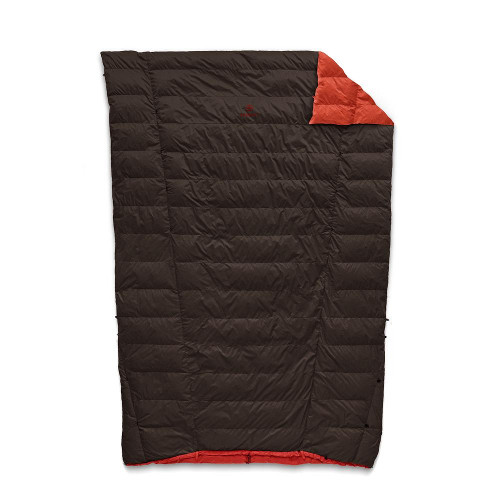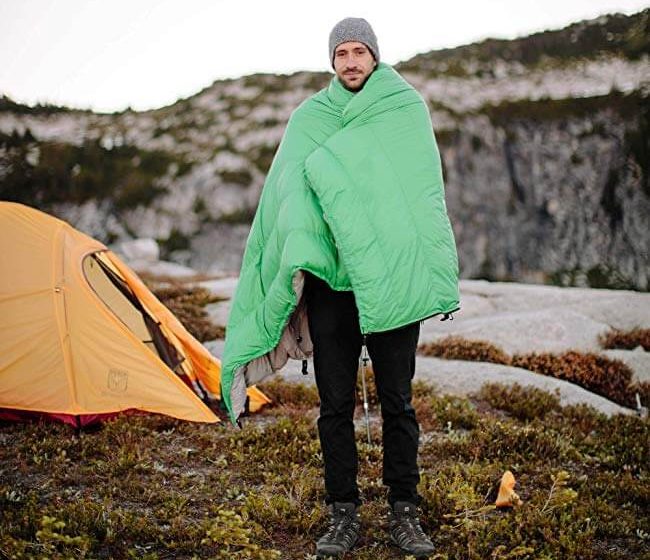
About 8 years ago, I first heard about backpacking quilts. As a die-hard gram weenie at the time (I’ve loosened up a bit) quilts were a big deal. They’re lighter than any equivalent mummy bag and pack up smaller, too! At the time, however, they were very pricey and only made by a handful of small manufacturers.
More...
Today quilts are easy to find! Many manufacturers are making them and even some of the mass-produced ones give high-end models a run for their money. In this article, I hope to shed some light on what types of backpacking quilts are right for you.
We’re going to talk about what they are, why they’re important, who should have one, and which ones are worth your cash! Of course, everyone is different so I’ll do my best to help you decide based on your individual situation. Along the way, I’ll toss out some pro tips from my years spent guiding backpacking trips around the US.
Comparison Chart
Name | Price | Weight | Rating | Notes |
|---|---|---|---|---|
$$$ | 22.33 oz | Cell | All quilts are MADE TO ORDER and ship from our shop located in Jackson, Michigan, USA. | |
$$$ | 13.7 oz | Cell | Can be used either as a top summer quilt (in a hammock or on the ground) or as a hammock underquilt | |
$$$ | 21 oz | Cell | MLD has been building ClimaShield Apex synthetic backcountry style quilts longer than any other company. | |
$$$ | 1.55 lbs | Cell | ||
$$$ | 14.6 oz | Cell | Quilts do not have hoods – you will need a warm hat on chilly nights. | |
$$$ | 2.2 lbs | We're a US-based company that offers a lifetime warranty on all of our gear. | ||
$$$ | 1 lb | ENO attempts to reduce potential waste by using every bit of fabric available in production, so the color of the stuff sack and stitching might vary from what is pictured. | ||
$$$ | 1.2 lbs | Perimeter snap loops mate with another Therm-A-Rest quilt, Blanket, sheet or mattress snap kit | ||
$$$ | 17.8 oz | The Revelation APEX is a quilt, not a sleeping bag, which means it’s designed to be used with a sleeping pad to provide insulation underneath you, between you and the ground. The Revelation APEX doesn’t have a full-length zipper or a built-in hood, saving weight and space in your pack. | ||
$$$ | 1 lb 12 oz | This is all made possible by our LoftTek™ insulation that looks, acts and feels like down, but has a siliconized coating causing water to drain out of the insulation. | ||
$$$ | 1 lb 14 oz | Add a Zenbivy Light Sheet to create a full EN rated sleeping bag, and even more comfort options. |
Pros and Cons of Backpacking Quilts
Backpacking quilts aren’t for everyone. And while they have some major advantages over traditional options such as bivy sacks, they also have a few big downfalls.
Pros
Cons
Backpacking quilts are still mostly being manufactured by small companies. That means you get great customer service and highly customized cutting-edge products.
However, it also means they can be hard to find short of hours of Google searching. Understanding the technical jargon can also be intimidating. Ordering a quilt often means choosing the down insulation, the fabric, the length of the bag, and understanding those specs.
Don’t worry, we’re about to lay it all out plain for you!
How to Choose the Best Quilt for You
It’s impossible to name one single quilt as “the best” because the one with the greatest features for me may not be the same for you. Instead, let’s look at the important factors that go into making and choosing a great backpacking quilt so you can understand which ones matter the most to you!
Quilt Shell Material
The shell of a quilt is that outermost layer of fabric that the quilt is made from. Usually, it’s a lightweight slippery feeling material that appears shiny.
This fabric material needs to be durable, lightweight, water-resistant, tear-resistant, and be able to hold up to dirt and grime.
As it turns out, the materials of choice are usually either nylon or polyester. Both of these materials have come a long way in recent years and there are many variations in construction and finish with each fabric.
Today, most fabrics used in good quilts are down-proof meaning they possess a tight enough weave to prevent down from “leaking” out of the jacket. Sometimes, however, feathers get mixed in with quills which can be sharp and work their way through the shell material. There’s just no way of perfectly getting around this.
Both nylon and polyester fabrics used in quilts can be treated with things like DWR to help shed water. On the flipside, however, these water-resistant treatments can reduce breathability which could cause a clammy feeling sleeping situation.
If you do run into a quilt (or even sleeping bag) offered with waterproof material just avoid it altogether. If they do get wet, they take ages to dry out and they’re a lot like sleeping in a plastic bag – they trap tons of body moisture. Yuck.
Every year, new fabrics hit the market that are a bit lighter, a bit more durable, or a bit more down-proof. For that reason, instead of recommending a specific fabric, I’d encourage you to look for something in the 10-15 denier range.
Denier is a measure of fabric thickness and is usually represented as a number followed by “D” as in (10D). Fabrics in the 10-15 denier range of nylon or polyester are usually about as light as it gets while still being durable enough to hold up in the field over time for most people.
As fabrics continue to improve ripstop fabric becomes available in lighter and lighter fabrics. Ripstop fabrics have thick strands of heavy-duty fabric woven into the lightweight sheets. These add durability and tear-resistance without adding much weight.
While the lightest fabrics out there may not necessarily be “ripstop”, many polyester and nylon weaves are resistant to tear propagation by nature so don’t be turned off by a fabric that isn’t specifically ripstop style.
Quilt Fill Material
For most modern sleeping bags there are only two types of fill material that are used for insulation. Either synthetic insulation (man-made) or down insulation from ducks or geese will be used in these bags.
For quilts, down insulation is almost exclusively used. Remember, the whole point of a quilt is to reduce weight and in achieving that goal down insulation is the fill material of choice.
While down does have a few drawbacks, it is inarguably lighter and more compressible than the equivalent synthetic insulation. For this reason, it is the insulation fill material of choice in 90% of quilts.
That said, there are some strong arguments to be made for synthetic insulation. Synthetic insulations tend to be a much more affordable option for many people, often half or less of the price of an equivalent down bag.
Synthetic insulation is particularly excellent at retaining a greater insulation value when wet than down can achieve. However, some modern water repellant down insulations makes a strong case in the opposite direction. If not now, then soon, I suspect we will have down insulation that is as good or better at retaining warmth when wet than synthetics.
Those who struggle the most with down insulation are usually beginner hikers. If you fail to set up your tent or tarp properly, get water inside your backpack that wets out the quilt, or otherwise accidentally get your down insulation wet then you may have a problem on your hands.
Over time, and with practice, you’ll eventually get proficient enough with your gear and systems that wet sleeping bags or quilts is rarely if ever a problem.
Down Fill Ratings Explained
You’ll eventually run into fill power ratings with down insulation. These are usually listed as 3-digit numbers ranging mostly from about 600-900 though other fill powers are possible.
This number represents the number of cubic inches of space a single ounce of down insulation will occupy when expanded. So, for instance, one ounce of 600 fill power down will expand to 600 cubic inches.
It follows, then, that the higher the fill power rating the better the down insulation is at its job. You want to most insulation, or loft, per ounce of down in order to minimize the weight of a given quilt.
In the same spirit, down insulation of higher fill power is usually correspondingly more expensive than lower fill power down.
When I explain it to people I try to show that fill power is simply a trade-off of performance. There’s nothing wrong with a 600 fill power quilt, but it will weigh more than a 900 fill power quilt.
Often the weight differences are quite minimal, one or two ounces maybe, while the cost difference can be several hundred dollars between a 600 and a 900 fill power quilt.
What’s more important to you: weight or cost?
Baffles Explained
When you make a down bag or quilt it’s important to create baffles. Baffles are the rows of sewing that keep the insulation inside from moving around too much on its own.
If you were to create a quilt sized bag without baffles, all the down inside would surely slide to one side or the other. You’d go to sleep and wake up with all the down having slid to the feet or the head of the bag. Of course, that would ruin the insulation value of a quilt.
In order to keep the movement of down insulation within certain restrictions, baffles are used to separate down into individual tubes of insulation.
Of course, the problem with this comes when you sew all the way through a bag or quilt from the inside to the outside. This is known as “sewn-through” construction.
Sewn-through construction results in the bag being pinched together at the line of stitching. Consequently, there is no insulative value in that area and heat from inside the bag “leaks” out through the stitching lines effectively ruining the warmth rating of a bag.
Sewn-through bags and quilts are, however, much cheaper and easier to produce than those with baffles. Therefore, if you have a low budget and need a quilt for warm summer conditions, considering a sewn-through construction method might make sense.
Baffles, on the other hand, are spacers of fabric sewn in between the inner fabric and outer fabric of a quilt. They create chambers where the down can be contained while also allowing the down to expand thereby resulting in a quilt or bag where the insulative value of the resulting bag is as high as possible.
Baffles, from a manufacturing standpoint, are much harder to make and produce than simple sewn-through construction. They are, however, critically important in achieving a good insulation rating for cold temp quilts. Therefore, I always recommend looking for quilts with baffles in any temperatures below about 40 degrees or so.
Choosing a Length
This one is pretty straightforward but it’s worth mentioning. You’ll need to be sure you order a quilt that is long enough to accommodate your height.
There’s only really one way to do this – check the manufacturer’s sizing guide. Measure your height and compare it to the listed specs from wherever you’re ordering.
One last note – double check the quilt width, too! A quilt that’s too narrow will lift up (particularly for side sleepers) and let all the cold air in. Conversely, a quilt that’s excessively wide for you will have wasted material weighing you down in your pack which you don’t really need. Be exact with your measurements
Quilt Features
Quilts, by their nature, lack a hood like a mummy bag might have. They also don’t have any fabric or fill on the bottom – the side you might otherwise lay on.
Instead, quilts often have some of these features:
Personally, I like a neck snap closure and an adjustable foot box. If you tend to thrash around in your sleep, however, straps might be necessary to keep the quilt from sliding off.
Adjustable and openable foot boxes are great because they allow you to open your quilt right up and lay it flat like a blanket. This is an awesome way to cool down or sleep during the summer months!
Best Lightweight Backpacking Quilts of 2019
These custom-made quilts are hand-sewn and crafted by cottage industry companies. Most of these companies started making quilts at home in their basements and have now grown to lead the industry with the lightest weight quilts anywhere.
Depending on your needs you can often even have quilts custom made from the companies on this list. Their quality, service, and options will astound you!
These quilts are ideal for those with moderate to high budgets looking for the purest ultralight quilts on the market.
UnderGround Quilts (UGQ Outdoors) has been and remains one of my all-time favorite quilt manufacturers for backpacking. These guys know what they’re doing and they’re using leading-edge materials for all their quilts.
Right now the UGQ Bandit is as good or better than any other quilts on the market in terms of weight and performance. On top of that, Paul who runs UGQ is famous for his great service and customer support.
When you order from UGQ you can either order a premade quilt or have one made for you. You can choose the exact type, denier, and color of fabric for your quilt as well as specify which features and what fill power of down you’d like to use on your quilt.
Expect to pay anywhere from $200 – $400 for your quilt depending on what features and options you decide to choose.
These quilts are available in any temperature rating from 50 degrees F to negative temperatures of your choosing.
If you can’t find what you’re looking for from any other manufacturer, chances are UGQ can probably custom make it for you!
Jacks R Better, like UGQ, is a small shop making great quilts. They produce several quilts of different styles, temp ratings, and fill but we’ll focus on this one for now.
Their Shenandoah is a quilt that comes in just under 12 ounces for a 40-degree temperature rating (regular). They kept it simple, too – it’s just a straight up rectangle shape which adds to the versatility and roominess.
With a price tag (as of this writing) in the mid to high 200’s, however, it’s a heavy proposition on the wallet. Yet it ranks similarly in price and performance to quilts like the Sea to Summit Ember (though they’re different temp ratings so don’t compare them apples-for-apples).
Take a look at the High Sierra Sniveller quilt for a 0-degree option from Jacks R Better when the mercury drops!
MLD has been working to keep themselves at the leading edge of ultralight gear for years. They might even have pioneered some of the first versions of several ultralight standards, but who knows.
In that same vein, they’re still making these great ultralight quilts that will give most others a run for their money.
Let’s compare the 38-degree quilt since it’s similar to some others on our list. They’re priced in the low $200’s and weigh in between 15 – 21 ounces.
On the bottom is a couple of sleeping pad straps. You’ll also find a cinch strap at the foot box.
Overall I’d say this quilt stacks up to about in the middle of the pack. It’s not the lightest weight quilt nor is it the cheapest.
If you’re not finding the quilt for you elsewhere, make sure to take a look at the Spirit Quilts before you move on.
Best Down Quilts for Backpacking 2019
These off-the-shelf down bags are easily available at retailers both online and on the shelf.
Consider these options if you don’t have any specific needs and a more general off-the-shelf option will do just fine for you.
Some of the quilts on this list even give custom-made quilts a run for their money!
Sierra Designs has some cool new quilts that are affordable, feature-rich, and well executed.
Maybe one of the coolest features on these quilts is that they have a kind of hybrid mummy-style hood that you can use. It’s not a mummy bag, but it does have a little nest for your head that you can cozy into for extra warmth as an optional feature.
Otherwise, simply lay the quilt flat and use it as a regular backpacking quilt.
Depending on which model you choose they’re available in different temperature ratings and fill power from 700-800 fill.
They’re not going to be quite as light as some of the bleeding-edge cottage industry quilts, but they do strike a great balance of price, availability, and reliability that it near the ultralight end of the spectrum.
Sea to Summit has always been among my top brands for their price to quality ratio if that makes sense. With this quilt, however, they’re giving even the best competition a run for their money.
At just 14.6 ounces (regular, 30 degree) it is about as light as you’re going to find anywhere. That’s because the bag is made with 850+ fill power down.
You’ll find the bag available in size regular (up to 6′ tall) and long versions. Plus you can choose between 20, 30, and 40-degree temp ratings (F). The quilt also has a drawcord foot section so you can use it mummy style or open like a blanket.
Unfortunately, it’s only available in one color as far as I can tell. On top of that, the price tag is a bit higher than I’d like to see for a quilt of this quality.
Looking for an affordable, feature-loaded quilt that won’t break the bank? Sure, it might be a bit on the heavy side but it will definitely get the job done out there.
Using 700 fill power down Paria has loaded up on all the features you can think of and still kept it at 38 ounces for a 15-degree quilt.
That includes clips and straps for sleeping pad attachment, a zippered foot box with drawstring closure, and a collar cinch.
I’ll be honest, I think they could have skipped the foot box zipper and saved quite a bit of weight, but that’s a feature some people might like.
In the end, I think you’ll have a hard time finding a quilt at this 15 degree rating with a price this low. That said, there are definitely lighter overall quilts out there but you’ll pay a premium for them.
Maybe one of the heaviest quilts out there, the ENO tips the scales at 27 ounces for a 45-50 degree rated top quilt. That’s massively heavy, but there’s a catch.
This quilt comes in at under $100 at most retailers.
It’s hard to justify the weight of this quilt in the backpack unless you’re looking solely for the most affordable option out there and don’t care about price. Some of us might be in that category – particularly if you’re young and tight on cash.
For those who have deeper pockets and are looking for lighter weight quilts pushing the edge of ultralight, look elsewhere.
Therm-a-Rest is one of the bigger names in backpacking gear and they’ve made some awesome products over the years. In keeping with that, they’re now offering a really nice quilt/blanket for summer season use that makes a lot of sense to many backpackers.
On the outside of this quilt is a waterproof/breathable shell fabric which is a bit rare. That means added peace of mind against blown (or direct) rain especially for those using tarps or open shelters.
Just keep in mind that WPB fabric can also sometimes trap a little excess moisture while you sleep. Particularly in hot and humid climates, this can lead to a little bit of a sticky sleeping situation.
You’ll want to keep this blanket on the warm side – it’s really best in temps 55 F and above. That’s probably why they pitch it mostly as a blanket.
Best Synthetic Quilts for Backpacking 2019
Synthetic quilts are a solid choice for a couple of situations:
- Low-budget backpackers
- Extremely wet climates
- Those who are a little careless with their gear handling
If any of those sounds like you, check this list of quilts and start shopping! Just remember that synthetic tends to be heavier than the equivalent down bag.
Okay, so you don’t like the idea of down insulation. Maybe you want something cheaper, more resistant to water logging, or you prefer to avoid animal products. Here’s a mind bender.
This 40-degree quilt is based on the EE Revelation quilt – their tried and true down quilt. They kept almost everything the same and instead of using down, they switched to CLIMASHIELD APEX.
Inside and outside, this bag uses 10D ultralight fabric with a light DWR coating which further improves water resistance. That means this quilt is a top pick for super wet environments or those who aren’t confident about keeping their gear dry.
You’ll also find the price tag well below most other quilts. That’s mostly thanks to the fact that synthetic insulation tends not to be as pricey as down.
At 17.8 ounces, it’s about 5 ounces heavier than most equivalent down quilts from other ultralight manufacturers, however.
If all else fails, consider this beast of a top quilt. At 28 ounces you’ll be hard-pressed to find anyone who would call it ultralight. However, the price is about as cheap as it gets so it could be worth a gander for those with extremely tight budgets.
You’ll get a sewn foot box (not openable or adjustable), a cinch at the neck, and a warm 30-degree synthetic quilt. When you consider this as a whole, it really might make a strong case for some backpackers.
It’s sewn with ripstop nylon so, if you’re someone who tends to be rough on their gear, it could be a quilt that stands up better to some abuse than many oober-light models.
With a price that’s just a shave over $100, it stands as a viable pick for low-budget backpacking.
Looking for a pretty solid synthetic quilt option that’s light on the budget and moderate in the pack? I’d rate this quilt as low on the price scale, moderate on the weight scale, and mid to high on the value scale.
At 26 ounces for the 40-degree synthetic quilt, it’s not the lightest quilt out there but the price seems to be right in the low 100’s.
Again, this style is ideal for those who think they might get wet, are hiking in particularly wet climates, or are just beginners with low budgets.
There’s not a lot of customization available here. Just choose from one of three available colors, pick from three size options, and you’re done.
I think they could have lightened this quilt up with a 10D fabric instead of the 20D they used, but hey at least it will be a bit more durable. It’s worth noting that there’s a DWR finish on the quilt.
Custom Backpacking Quilts
Quilts are a great option for those looking to minimize weight while maximizing efficiency. In fact, I would argue that there’s a strong case to be made for mummy bags to be largely phased out and quilts to see much more widespread use than they currently do.
Of course, this will take time as people learn the advantages and disadvantages of backpacking with quilts.
In the meantime, the best lightweight quilts on the market for your money are still being made by cottage industry manufacturers. While big names have entered the scene and started making quilts, their price versus technical stats just can’t hold a candle to advanced quilts offered by manufacturers such as UGQ Outdoors.
If you don’t find what you’re looking for on our list, try contacting some of the smaller manufacturers and inquiring about custom orders. Most of these cottage companies are happy to do custom work and can tailor your quilt to meet your exact needs. In fact, I had UGQ build me a custom 50-degree quilt not too long ago for just those reasons!
Why would you want a custom quilt? Maybe you know a quilt is right for you but you just can’t find a quilt being made with the exact features and specifications you’re looking for. That’s when it’s time to reach out for a custom order!
Some things people customize might include:
- Number or placement of straps
- Style of the foot box
- Extra insulation in certain areas (great for those who get cold feet!)
- Unique fabric type/color/pattern
- Warmer or cooler quilts than is commonly available
- Unusual sizing or shape requests
Just remember a quilt isn’t the one answer for all hikers. Alternatively, you can always go with a classic mummy bag. In some cases, their weight and bulk for the price you may pay can sometimes come out in a wash. Particularly for beginner backpackers and those on a budget, a more traditional option like a mummy bag might not always be a bad choice.

